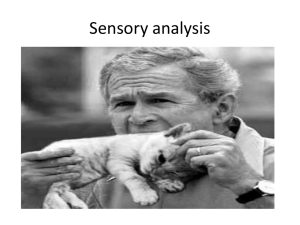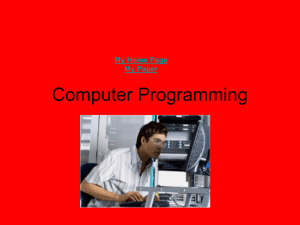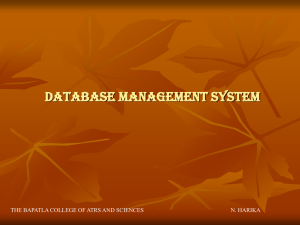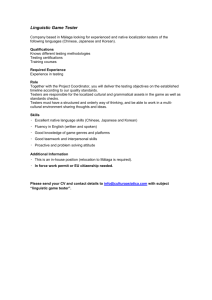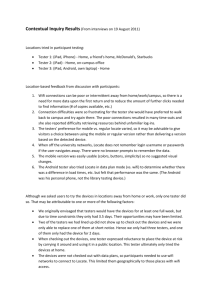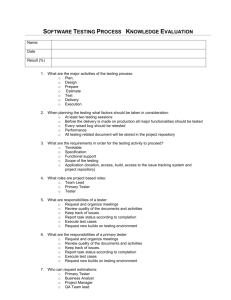Using Concept Mapping to Teach Software
advertisement
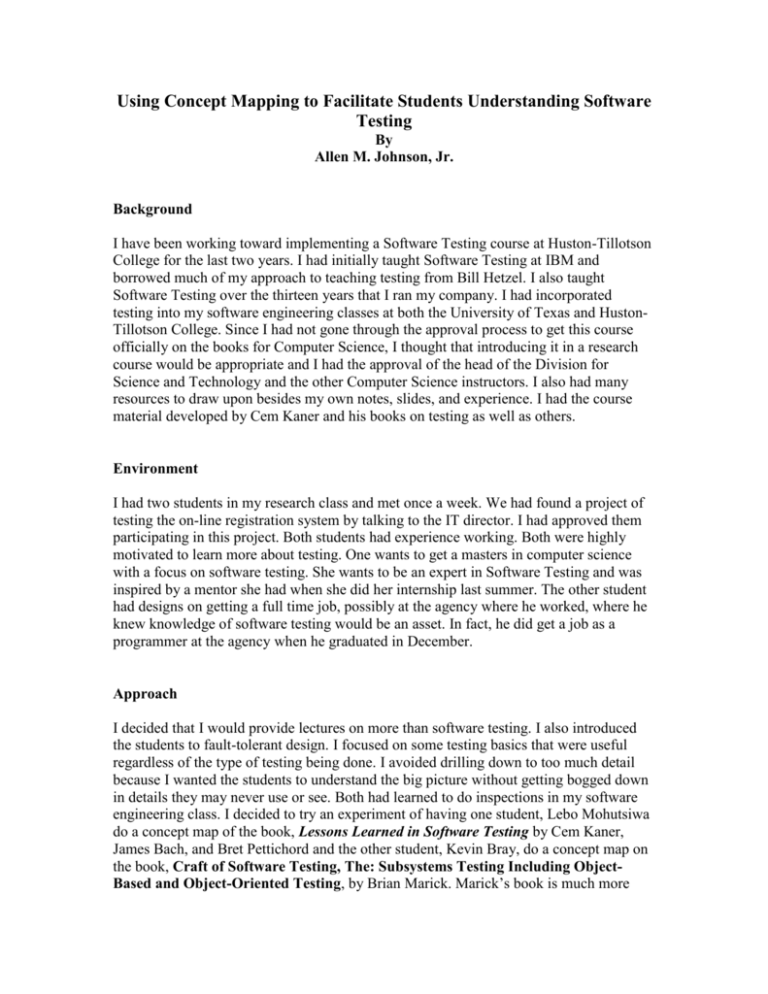
Using Concept Mapping to Facilitate Students Understanding Software Testing By Allen M. Johnson, Jr. Background I have been working toward implementing a Software Testing course at Huston-Tillotson College for the last two years. I had initially taught Software Testing at IBM and borrowed much of my approach to teaching testing from Bill Hetzel. I also taught Software Testing over the thirteen years that I ran my company. I had incorporated testing into my software engineering classes at both the University of Texas and HustonTillotson College. Since I had not gone through the approval process to get this course officially on the books for Computer Science, I thought that introducing it in a research course would be appropriate and I had the approval of the head of the Division for Science and Technology and the other Computer Science instructors. I also had many resources to draw upon besides my own notes, slides, and experience. I had the course material developed by Cem Kaner and his books on testing as well as others. Environment I had two students in my research class and met once a week. We had found a project of testing the on-line registration system by talking to the IT director. I had approved them participating in this project. Both students had experience working. Both were highly motivated to learn more about testing. One wants to get a masters in computer science with a focus on software testing. She wants to be an expert in Software Testing and was inspired by a mentor she had when she did her internship last summer. The other student had designs on getting a full time job, possibly at the agency where he worked, where he knew knowledge of software testing would be an asset. In fact, he did get a job as a programmer at the agency when he graduated in December. Approach I decided that I would provide lectures on more than software testing. I also introduced the students to fault-tolerant design. I focused on some testing basics that were useful regardless of the type of testing being done. I avoided drilling down to too much detail because I wanted the students to understand the big picture without getting bogged down in details they may never use or see. Both had learned to do inspections in my software engineering class. I decided to try an experiment of having one student, Lebo Mohutsiwa do a concept map of the book, Lessons Learned in Software Testing by Cem Kaner, James Bach, and Bret Pettichord and the other student, Kevin Bray, do a concept map on the book, Craft of Software Testing, The: Subsystems Testing Including ObjectBased and Object-Oriented Testing, by Brian Marick. Marick’s book is much more detail oriented than Kaner et al and has a different focus. I thought the contrast would be good. Kevin also volunteered to read Lessons Learned as well. They would do this concurrently with the lectures and testing the of the on-line registration system. To do the concept map I had them use free software called Cmap. The website for downloading and explaining how to use the software is at http://cmap.ihmc.us/. They were both required to do a Cmap in at least one other class that they had with me. Once, they did the Cmap, they were to save them on a public server. The concept maps were organized to correspond to the chapters of the book primarily. Then they would drill down on each topic as they saw fit. Mr. Bray did much more drilling down for Craft of Software Testing than Ms. Mohutsiwa for Lessons Learned in Software Testing. This was due in part to the complexity of one compared to the other book but also to personal preference. Results The students thoroughly enjoyed every aspect of the course. This was reflected in their enthusiasm and evaluation of the course. The lectures were more free form, designed to be responsive to the students needs and interest as well as convey things they had not learned else where. Doing the Concept map helped them get much more out of the books than they normally would have plus gave them a summary of the book that they can review very quickly whenever needed. For me as instructor, I was able to have much more intelligent conversations with the students about testing. Because there were only two students, I cannot generalize this result. Because they had an opportunity to apply what they learned in class and in the books to the project of testing the on-line registration system that gave them a sense of accomplishment, having done something not just for IT, but for the whole college including the student body. They saved their fellow students the pain of having to use buggy software that was not ready for prime time. They could now review any subject within the book very quickly provided they constructed the Cmap properly. They produced Cmaps which will be very useful to me and others in the future. They came away confident that they had learned valuable knowledge that they could use throughout their career. Both students followed the advice given in Lessons Learned in Software Testing. They followed much of the wisdom given in Chapter 1. They took the approach of touring the product and evaluating it (Chapter 2). They combined this advice with what they learned in software engineering which was to create use cases to help them more efficiently cover the possibilities and increase their chances of finding errors since they chose to perform function testing (chapter 2). The Cmap for Lessons Learned in Software Testing can be found at http://cursa.ihmc.us/servlet/SBReadResourceServlet?rid=1102123539624_863868580_8 43&partName=htmltext. The Cmap for Craft of Software Testing, The: Subsystems Testing Including Object-Based and Object-Oriented Testing, by Brian Marick. can be found at http://cursa.ihmc.us/servlet/SBReadResourceServlet?rid=1102283082731_1420542302_ 2493&partName=htmltext. Below is a look at the top Cmap page for Lessons Learned in Software Testing. Ms. Mohutsiwa typically only drilled down only one level and avoided a lot of detail. The Cmap also provides a test summary which is listed here. This text summary can be effective in reviewing and studying for an exam on the subject. ` The summary as given by Cmaptools is the following for Chapter 7 : The Concept Map you are trying to access has information related to: provide service by offering assistance to programmers directly, offering assistance to programmers directly like testing third-party components, offering assistance to programmers directly like setting up environments for programmers to use in their own testing, offering assistance to programmers directly like testing private builds and prototypes, offering assistance to programmers directly like reviewing requirements documents for testability, get testability features from programmers by asking early, get testability features from programmers by speaking their language, get testability features from programmers by being realistic, Chapter 7 "Interacting with Programmers" presents a tester's interaction with programmers, a tester's interaction with programmers a tester must understand how programmers think, a tester's interaction with programmers a tester must ask programmers questions about their work, a tester's interaction with programmers a tester must report credible problems accurately and directly, a tester's interaction with programmers a tester must Develop a programmer's trust, a tester's interaction with programmers a tester must provide service, a tester's interaction with programmers a tester must get testability features from programmers, a tester's interaction with programmers a tester must focus on the work, not the person The student summary of their software testing effort is the following: Function Testing of HTC-Online Registration System By: Kevin Bray & Lebogang Mohutsiwa Function testing means testing the function thoroughly, to the extent that you can say with confidence that the function works (Kaner, et al 33). It is wise to do function testing before doing more complex tests that involve several functions (Kaner, et al 36). We chose to do black box testing on the product because we did not know of the code behind it. The HTC online registration product came straight from the company to the college. The Information Technology department did not test the system before they put it in place for students to use. Our goal was to find bugs that could hinder online registration. Before we started testing the system, we decided to learn about how it functions. Each step was documented while we were familiarizing ourselves with the functions and sub functions of the product. This documentation guided us to think of scenarios of functions and sub functions of the product while we were testing it. IT department was going to use the documentation as part of the user manual for HTC students. We found errors in the system while learning how it worked before we began testing. This further supported our initial thinking that the product was never tested before. The system came straight from the company and was installed in the HTC server without being tested. Learning the system increased our chances of finding more bugs because we did not leave out any step. Function testing of the HTC online registration system began when we were confident that we knew how the system was supposed to work. This was our first time testing a system that was never tested so we needed a testing technique. We used the Five-fold Testing System which addresses testers, coverage, potential problems, activities and evaluation (Kaner, et al 32). This technique worked very well with our function testing plan to find bugs that could hinder the registration process. We were the first two testers to test the function. As far as coverage is concerned, we were determined to test every function to find bugs. Our activity involved the function testing of the system so we could alert the IT department of bugs immediately before the registration began. Using the same technique we made life easy for ourselves by using use cases for each function and sub function. A use case is a description of an interaction between an actor and the software product (Schach, 377). Examples of use cases in this case were transfer student, new student, returning student, classification and or different majors. All use cases were derived from the manual registration that was used every semester at HTC. For example, a returning student (actor) will go into the online registration system (software product) to choose classes for the semester. We then paid attention to this use case to think of any normal or abnormal scenario that could take place if a returning student attempts to register. Use cases really helped us narrow our testing to finding serious bugs in each function. We documented each defect with its screen shot and delivered the document to the IT department. It was good to hear that we found serious bugs that helped the IT department with their decision to use the system. We went in as testers who did not know anything about this product but that did not prevent us from learning about the product and testing it for bugs. We did not expect any help from product documentation because we never received any documents to review before we began testing the product. We learned that “a tester who treats project documentation (explicit specifications of the product) as the sole source of requirements is crippling his test process” (Kaner, et al 21). This project taught us about the different types of software testing techniques that exist. We learned to think like testers who make a difference by finding bugs. We also learned how to attempt testing under different circumstances. Works Cited Kaner Cem, James Bach and Bret Pettichord. Lessons Learned in Software Testing. New York: John Wiley & Sons, Inc. 2002. Schach, Stephen R. Object Oriented & Classical Software Engineering. New York: The McGraw-Hill Companies, Inc. 2002


